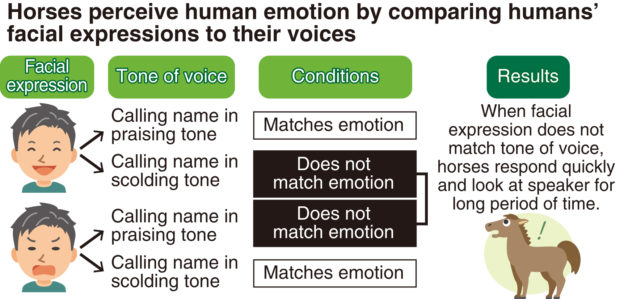Study: Horses can read human emotions
TOKYO — A team of researchers has added a new dimension to horse sense — according to a group including Hokkaido University Associate Prof. Ayaka Takimoto, horses are capable of perceiving human emotions through a combination of facial expressions and voice tones.
The team said its experiment showed that a horse responds more quickly to a human voice when the speaker’s tone does not match the facial expression that the horse sees. It was the first time that an animal other than dogs has been confirmed to have such a capability.
The results of the research were published in the British online science journal Scientific Reports on Thursday.
The researchers conducted the experiment from August to December 2016 on a total of 19 horses, in cooperation with equestrian clubs of the University of Tokyo and Tokyo University of Agriculture and Technology.
Horses were shown pictures on a screen of both a familiar person and an unfamiliar person, each either having a happy or an angry facial expression.
Article continues after this advertisementThey then heard a pre-recorded human voice calling the horses’ names in praising or scolding tones. The researchers observed how they responded to the various combinations.
Article continues after this advertisementAccording to the results, it took an average of two seconds for the horses to look at an image of the speaker when the facial expression of a familiar person matched the tone of the voice. In contrast, it took an average of 1.2 seconds when the facial expression did not match the tone of the voice.
When the facial expression of an unfamiliar person matched the tone of the voice, it took an average of 3 seconds until the horse looked at the speaker. It took an average of 1.4 seconds when the facial expression of an unfamiliar person did not match the tone of the voice.
Takimoto said, “It’s been known that horses are capable of perceiving human emotions through facial expression, but this research has shown that horses link human facial expressions and voices to perceive human emotions.”
